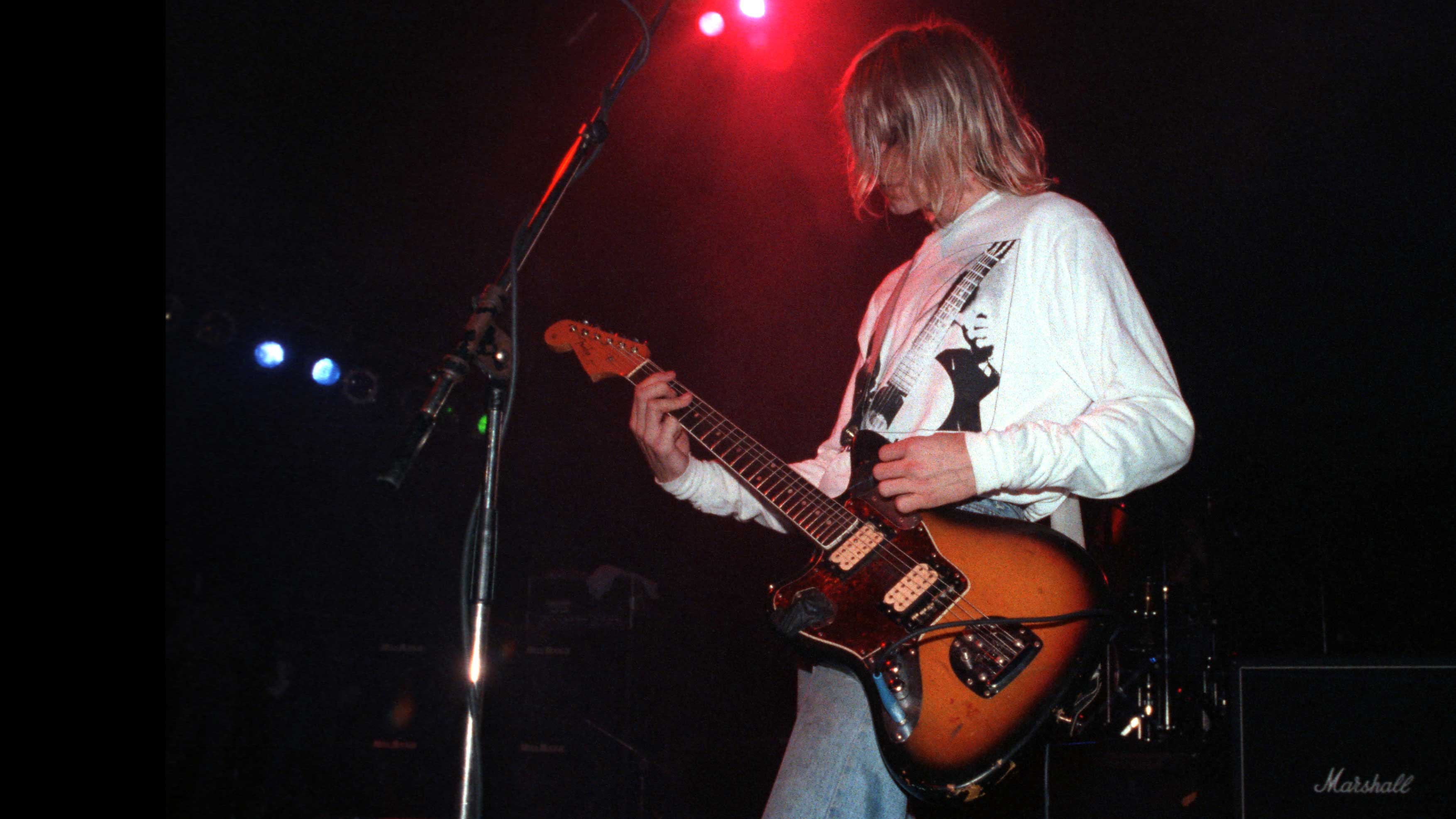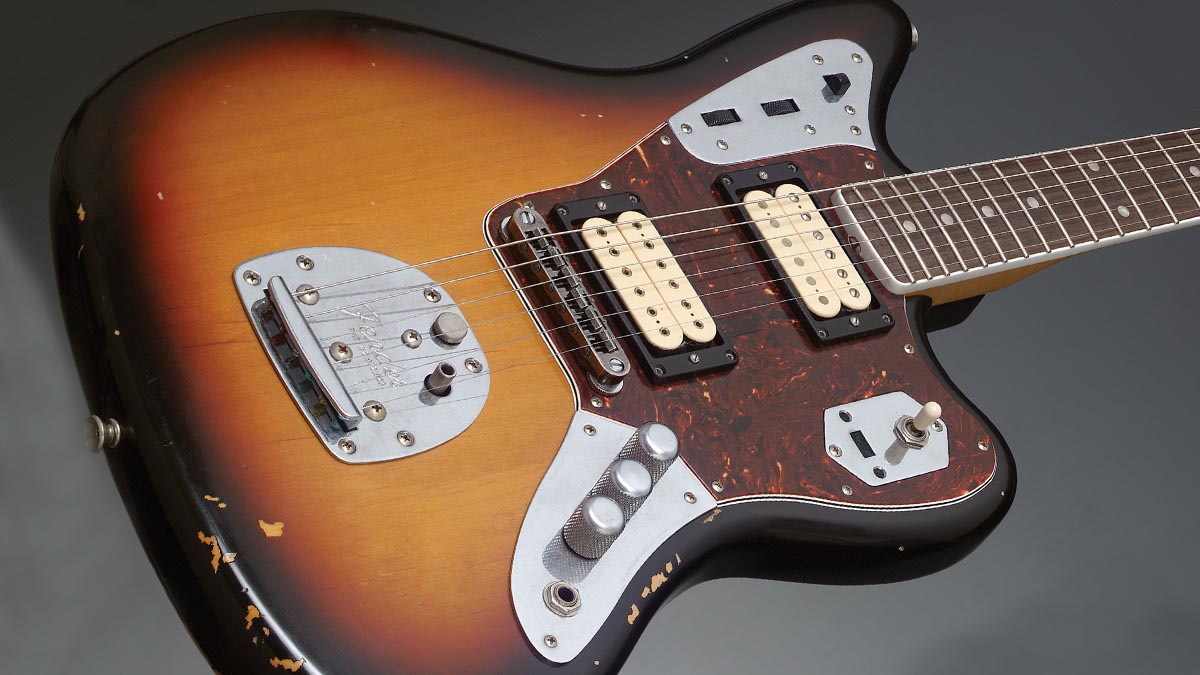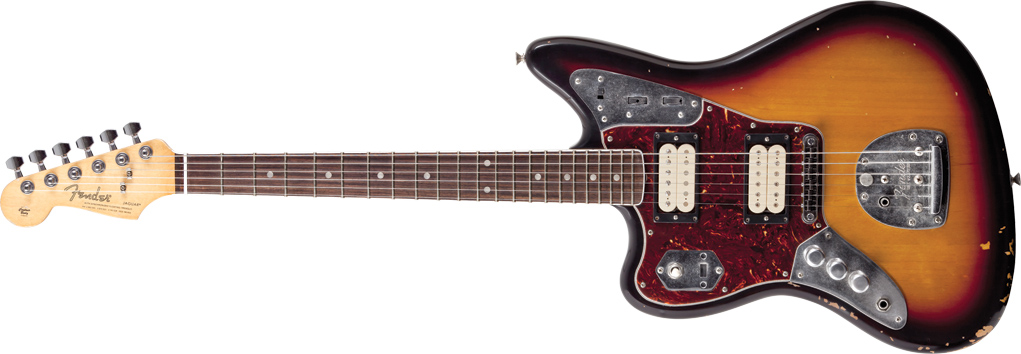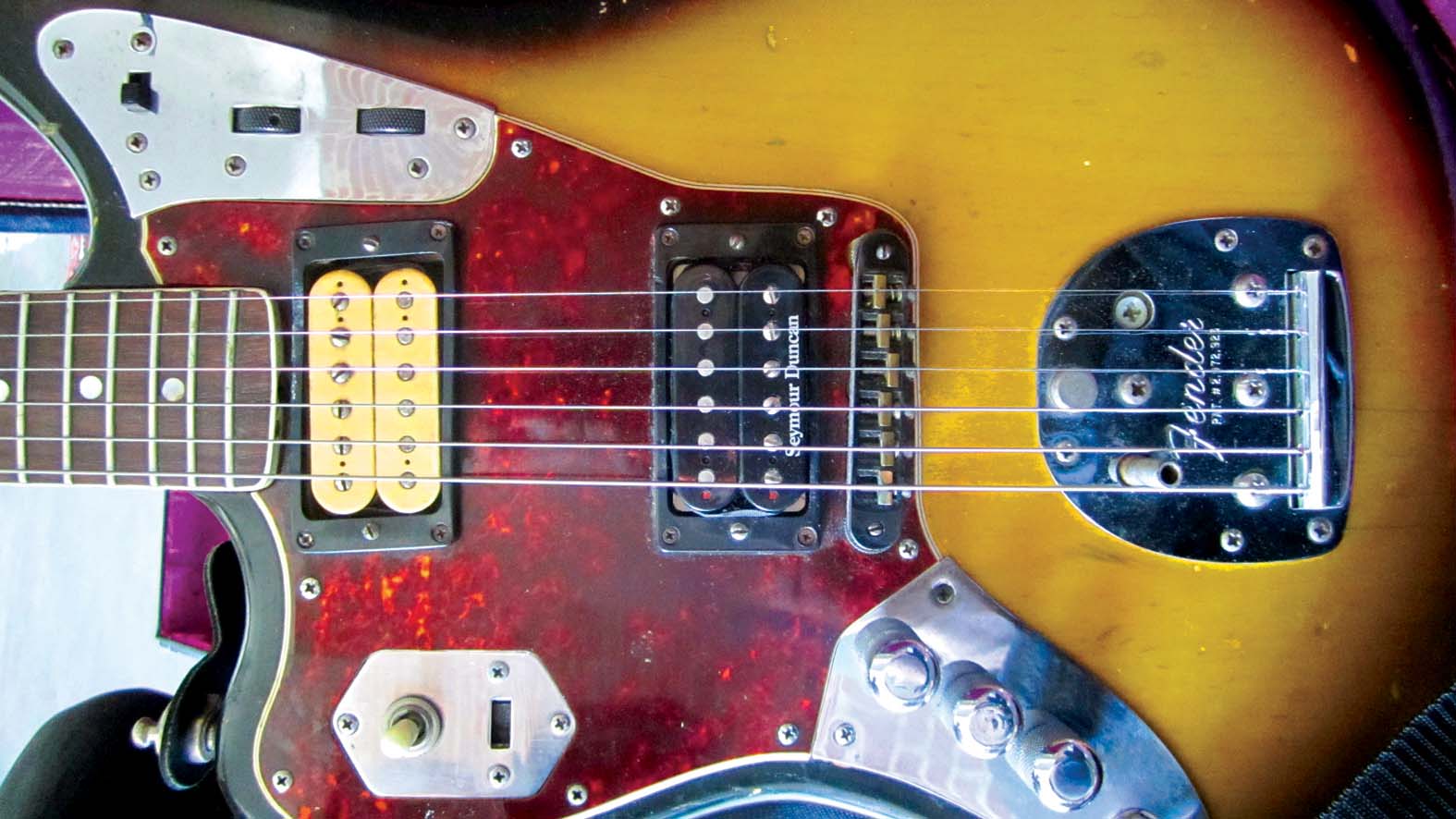The story of Kurt Cobain's Fender Jaguar
Charting the mods and myths of the Nirvana legend's iconic guitar

By 30 August 1992, Nirvana were headlining at Reading Festival and had arguably become the biggest band in the world.
In the 11 months since its release, Nevermind had established itself as the rallying cry of youth culture, and those honest, punk-infused 43 minutes had changed lives, music and attitudes. They had reclaimed rock from the clutches of hair metal and elevated a conflicted Cobain to the reluctant position of spokesperson for a generation.
Nirvana had also played Reading the year before. Back then, the band appeared sixth on Friday’s bill, but this time they would close the main stage on the last night of the festival. Speculations about Cobain’s health and heroin addiction were rife, and many were questioning whether the frontman would even show.
He did, but in reaction Kurt was pushed onstage in a wheelchair by journalist Everett True, stood to address the crowd and feigned a collapse. When he returned to his feet, Cobain was handed his 1965 Fender Jaguar.

Kurt’s Jag was one of the main constants of the Nevermind era. It featured in performances from the album release party at Seattle’s Beehive Records to Nirvana’s appearances on Saturday Night Live and The Word, as well as that crowning slot at Reading. While the Jag-Stang was Kurt’s official collaboration with Fender, it’s the Jaguar that has remained the most iconic instrument.
Fender’s Justin Norvell, a huge Nirvana fan, was the driving force behind the development of the Fender Kurt Cobain Jaguar, released in 2011. The project had been in the works for years, with the involvement of Kurt’s guitar techs Nick Close and Earnie Bailey, Nirvana’s management and the Cobain estate.
“I’ve been doing this job since early 2005 and this guitar was one of the first things I started chasing down,” says Norvell.
Want all the hottest music and gear news, reviews, deals, features and more, direct to your inbox? Sign up here.
“Fender always felt that the Jag-Stang was cool, because it was Kurt’s vision. But, at the same time, it was kind of posthumous. So what we’re left with is the legacy, and I felt that it’d be really great to honour Kurt and the fans with something a little bit more authentic to what he was playing.”
There’s always been this mystery: who owned that guitar? And why haven’t they come forward?
Nirvana tech Earnie Bailey
Kurt purchased the Jaguar used through the LA Recycler in 1991. Its unusual mixture of modifications and non-period-correct features has been the source of plenty of questions over the years, starting with the quandary of its previous owner.
The guitar came in an Anvil flight case, which are usually the preserve of high-profile touring bands, recalls Earnie Bailey.
“To me that’s the greatest mystery,” he says. “You’re probably talking about a guitar that at the time was worth maybe $300. So someone had commissioned these really extensive modifications on it and then paid for a flight case for it. It looked to be a touring band.
“So there’s always been this mystery: who owned that guitar? And why haven’t they come forward and said ‘Hey, that was my guitar,’ or, ‘Here are some photographs of me playing it in 1978.’”
Recent fan theories point towards Martin Jenner, guitarist for Cliff Richard and The Everly Brothers, but these have yet to be confirmed.

The guitar also featured a Fender ‘spaghetti’ logo, which by 1965 had been phased out of production, as well as a Strat-size headstock and small Jaguar lettering. Norvell gained access to Kurt’s original through its current, undisclosed owner and is able to shed some light.
“One of the things people were thinking was that it was a non-original neck with some kind of knock-off decal. I would say that from looking at it, it appears to be original and correct,” Norvell notes.
“The binding and pearloid dots are both period correct to ’65, but I think a left-handed, 24-inch-scale Jag neck was kind of an odd request back then. It’s just one of those oddities that came out of the factory that wasn’t quite right.”
The modifications play a key part in the guitar’s identity and Fender included each one in its recreation. The regular Jaguar single coils had been swapped for DiMarzio humbuckers, with a PAF in the neck position and a DiMarzio Super Distortion in the bridge. (Earnie changed the latter to a Seymour Duncan JB around In Utero.)
A three-position toggle, rather than a trio of Jaguar slide-switches, controlled the pickups. The toggle was mounted on the switch plate on the treble horn, and an extra volume pot had been added to the control section.
In most pictures of Kurt playing his Jag live, gaffer tape covers the toggle switch plate. When it doesn’t, what seems to be the original slide-switch, or at least space for it, can be seen.
When I got access to Kurt’s guitar, the [pickup selector] switch was completely snapped off inside of it and it’s hooked to nothing, so it’s blank
Justin Norvell
“None of the internet lore really pointed to that,” Norvell says. “When I got access to Kurt’s guitar, the switch was completely snapped off inside of it and it’s hooked to nothing, so it’s blank. There’s nothing there, so we just have a piece of black insulation that covers that area.”
Finally, the Jaguar’s rhythm circuit controls have been included on Fender's updated version.
“The upper controls were engaged and disengaged over the years,” says Norvell, “but for the tribute we’ve engaged them, because you might as well. We didn’t want people thinking the guitar is broken.”
It wasn’t just the electronics that had been overhauled: the hardware had been replaced with a black chrome Gotoh bridge and Gotoh machineheads.
“It’s got Gotoh tuners with the diagonal screwplate on there and, as with the Rory Gallagher Stratocaster, we left the original screw holes on the Kurt Cobain guitar,” Norvell explains.

While the Jaguar is the most recognisable guitar from this era, Kurt also had a collection of new Fenders, mainly Stratocasters and Mustangs. These inevitably underwent the gig-closing ritual of being smashed, so Kurt’s black ‘Vandalism’ Strat is perhaps the only contender to the Jaguar’s fame.
The guitar takes its name from the sticker stuck to the body, which reads, “Vandalism: as beautiful as a rock in a cop’s face.” The sticker came with the album Teachers In Space by Arizona punk band, The Feederz.
“It seemed like when he first got [the Jaguar], Earnie explains, “he used it as a backup; he was mainly playing that black Vandalism Strat around the time. And then the Vandalism Strat got smashed in France – it was destroyed at that point – and then the Jaguar moved into the number-one slot.”
Kurt may have destroyed his fair share of guitars, but the Jaguar remained in one piece, although not for a lack of trying. The video for Lithium shows Cobain attempting to pull its strings off. Another clip sees him slam it into the ground onstage in Rotterdam in 1991. He also hit a bouncer in the face with the butt at the Trees club in Dallas, Texas.
And during a bad show in São Paulo, Kurt pounded a cantaloupe melon into the Jag’s body, much to the horror of Earnie Bailey: “I remember looking at it and thinking, ‘God, I don’t want to clean that up.’”
It’s no surprise, then, that the guitar shows more than a few signs of its life with Cobain, which Fender was keen to replicate with its (now-discontinued) Road Worn model.
As such, the Kurt Cobain Jaguar has been sprayed with a nitrocellulose finish. This not only ages well over time, but is more accommodating to future dings than polyester finishes. But before Fender could set about adding the battle scars, it had to match the original finish.
“It’s pretty faithful to the real thing,” Norvell says. “We were looking at photos before we got to see the guitar and in some it looked like a very clear three-tone, but in others it looked like a two-tone or tobacco burst.”
Earnie Bailey on keeping Kurt’s guitars alive
Contrary to popular belief, Kurt’s seemingly endless supply of guitars consisted of just a handful, which Earnie kept going by rotating the working parts.
“At one point, I was trying to put together a chronology of how many guitars he owned,” says Earnie, “and the number isn’t really that much. I think somewhere in an interview he claimed it was around 200, but in reality I think it’s closer to maybe 50… A lot of what you see from ’91 through to the end is the same five, six, seven guitars just being recycled over and over again with different parts.
“You know, you change the pickguard, put a different colour on there, change the neck and suddenly it appears to be a different guitar. We’d keep ’em out there until they really were beyond repair.”
Once they’d seen the guitar, Norvell and his team could determine why: “Probably because it was played outdoors a lot, the red stripe of the three-tone sunburst fades out a lot on the front. Over time, the red is the layer that seems to disappear first, but the black and amber stay.”
Cobain’s punk-rock ethics doubtless had an influence over his love of inexpensive instruments, and while the Kurt Cobain Jaguar is by no means cheap, it’s a snip compared to a genuine ’65 Jag.
According to Norvell, keeping the cost down was a big priority: “Kurt wasn’t about a £10,000 museum piece to be put in glass above one’s mantle. He was very non-precious with guitars. It was definitely more true to that DIY punk spirit to keep it as low a price point as possible…”
Less than two years after Nirvana’s Reading high point, Cobain was dead. But 20 years on from the release of Nevermind, the band’s legacy continues to resonate. Kurt’s guitar playing inspired millions of guitarists globally and continues to prove that spirited playing can capture imaginations just as much as technical ability. We’ll leave the last word to Norvell:
“I know there are tons of signature models… but we really wanted it to be super-authentic and respectful. I think even though Kurt wasn’t a shredder, he was kind of the Jimi Hendrix of our generation. He really changed things and moved music into a different place.”
Don't Miss
Fan uncovers previous owner of Kurt Cobain's Fender Jaguar

Stuart has been working for guitar publications since 2008, beginning his career as Reviews Editor for Total Guitar before becoming Editor for six years. During this time, he and the team brought the magazine into the modern age with digital editions, a Youtube channel and the Apple chart-bothering Total Guitar Podcast. Stuart has also served as a freelance writer for Guitar World, Guitarist and MusicRadar reviewing hundreds of products spanning everything from acoustic guitars to valve amps, modelers and plugins. When not spouting his opinions on the best new gear, Stuart has been reminded on many occasions that the 'never meet your heroes' rule is entirely wrong, clocking-up interviews with the likes of Eddie Van Halen, Foo Fighters, Green Day and many, many more.